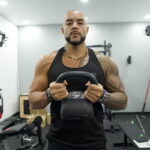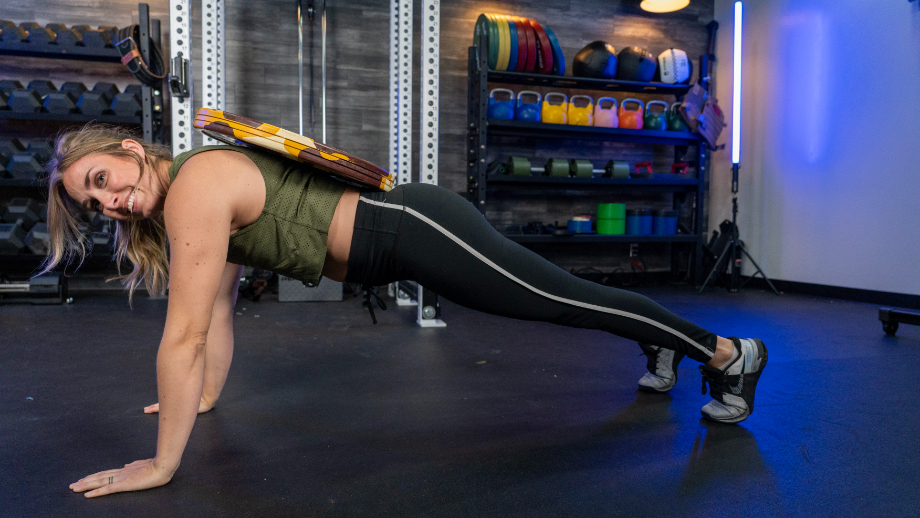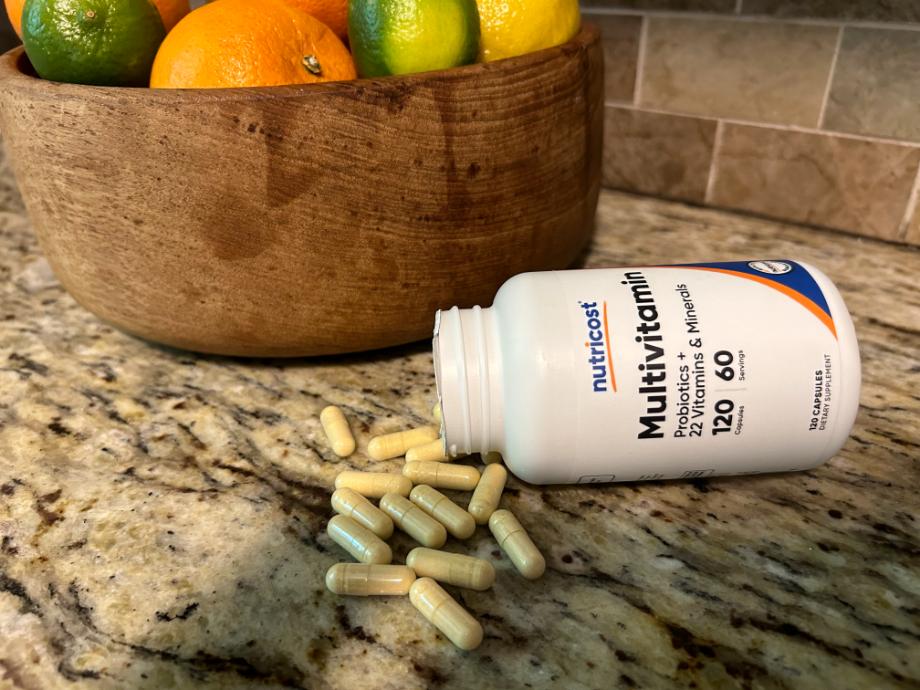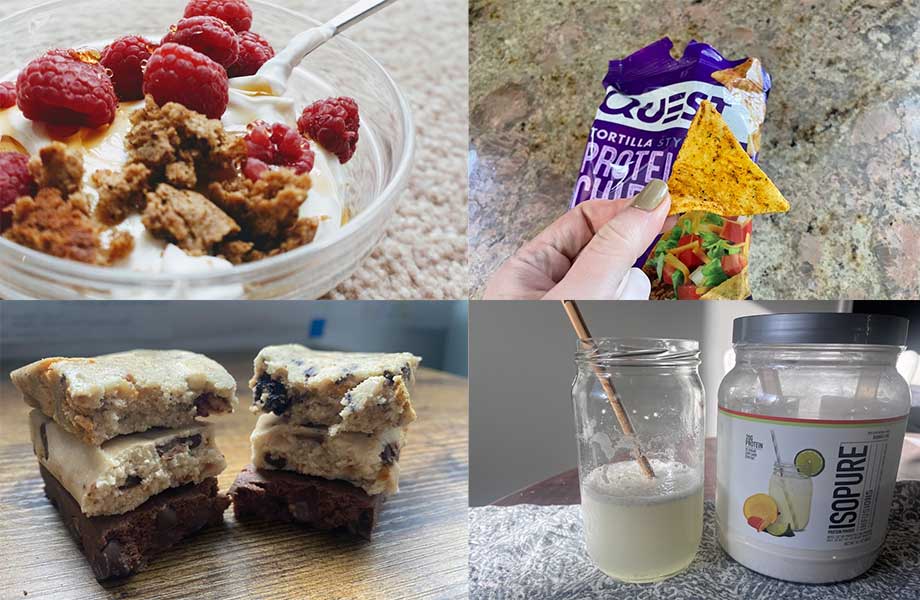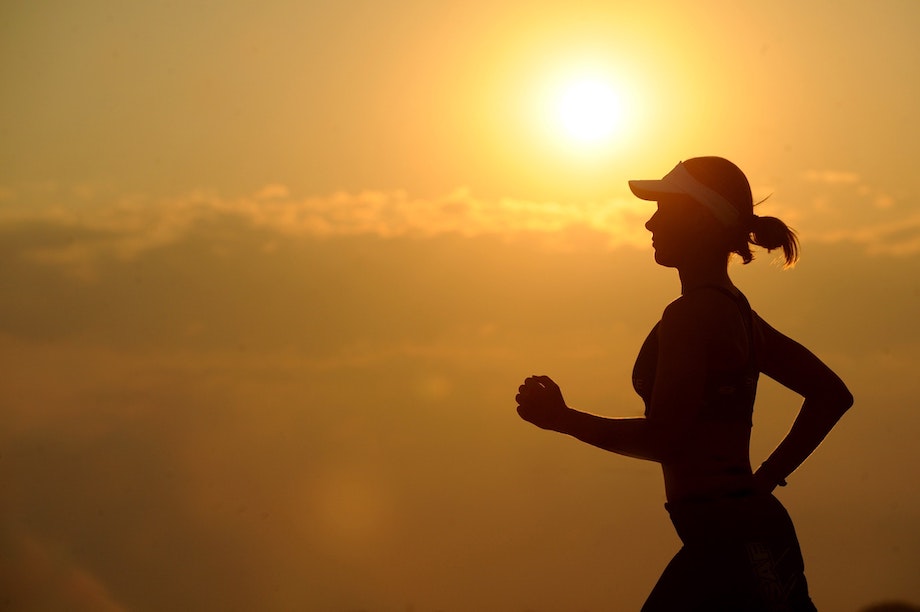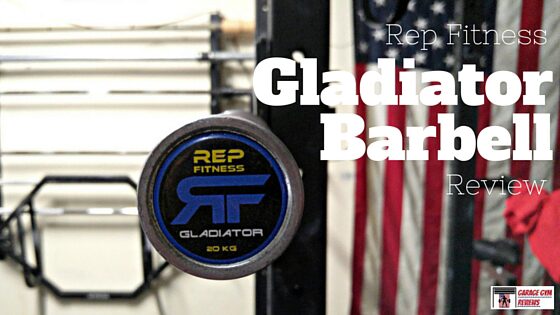From barbells and dumbbells to kettlebells and resistance bands, you have nearly endless options for building muscle, developing strength, and improving your cardiovascular conditioning. As a certified personal trainer (CPT) who enjoys using a variety of tools to help clients achieve their fitness goals, I believe one of the most underrated pieces of equipment is one that many lifters view as a side dish rather than a main course: weight plates.
RELATED: Best Weight Plates
While some lifters use light ones for low-impact warm-up exercises like lateral raises and arm circles, the majority slap plates on an Olympic barbell to bang out back squats and deadlifts. However, what if I told you that you don’t need a bar to put those plates to work?
Whether you want to build boulder shoulders, add size to your legs, or develop a more resilient core, you can rely on weight plate exercises to get the job done. So, get ready to test your grip strength and mental resolve with plate-based workouts you can perform at home at any time.
18 Weight Plate Exercises To Add to Your Routine
Narrowing down my favorite weight plate exercises was no easy feat. After all, you can use this popular piece of home gym equipment for a variety of movements that target different muscle groups.
Ultimately, I put together an eclectic list of 18 movements that cover everything from your shoulders and chest to your legs and core.
- Squat reach
- Overhead lunge
- Reverse lunge and twist
- Thruster
- Bridge pullover
- Standing chest squeeze press
- Shoulder press
- Bent-over row
- Front shoulder raise
- Plate push-up
- Overhead triceps extension
- Farmer’s walk
- Halo
- Russian twist
- V-up
- Side bend
- Woodchopper
- Weighted plank
Note: While some of the demonstrations below will show alternate weights. Rest assured, you can perform each movement with a single (or set of) weight plates.
Squat Reach
Muscles worked: Quadriceps, hamstrings, glutes, calves, deltoids, core
Benefits: You can never go wrong with penciling a dynamic squat variation into your strength training program. The squat reach not only targets your glutes, quads, hamstrings, and calves, but also your shoulders, triceps, and upper-back muscles, as you have to press the weight plate forward at the bottom of the movement.
How to do it:
- Stand with your feet shoulder-width apart while holding a weight plate against your chest.
- Descend into a squat position by driving your weight through your heels.
- Thrust the weight plate forward, keeping your arms extended and parallel to the ground.
- Push through your heels to rise back to the starting position, pulling the weight plate back to your chest.
- Repeat for the desired number of repetitions.
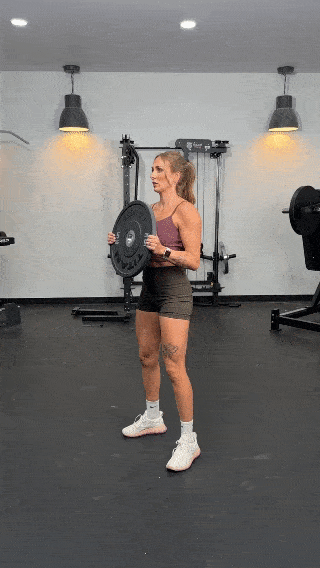
Modifications
- Dial it back: Keep the weight plate against your chest to perform something similar to a goblet squat.
- Make it harder: Perform two horizontal presses at the bottom of the squat for a more intense upper-body workout.
RELATED: What Muscles Do Squats Work?
Overhead Lunge
Muscles worked: Quadriceps, hamstrings, glutes, deltoids, trapezius, core
Benefits: The lunge is a fundamental movement pattern that can enhance your lower-body strength and stability. The overhead lunge takes things a step further by getting your core and upper body involved. This variation tests your balance and coordination while also allowing you to address any muscular imbalances by working each leg independently.
How to do it:
- Stand with your feet shoulder-width apart.
- Hold a weight plate overhead with both hands so your arms are fully extended.
- Step forward with your right leg and lower your body by bending both knees until your right thigh is parallel to the ground.
- Keep your core engaged and arms extended, then push through your right heel to return to the starting position.
- Repeat on the other side, alternating legs for the desired number of reps.
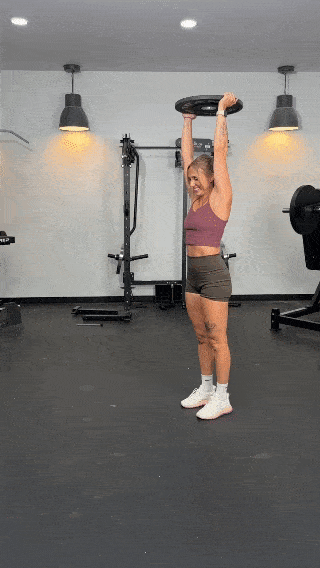
Modifications
- Dial it back: Perform the overhead lunge without any weights until you feel confident that your shoulders are stable and mobile enough to handle holding a weight plate.
- Make it harder: Hold the bottom of the lunge for three to four seconds to increase time under tension.
RELATED: What Muscles Do Lunges Work?
Reverse Lunge and Twist
Muscles worked: Quadriceps, hamstrings, glutes, deltoids, rhomboids, trapezius, obliques, abdominals, erector spinae
Benefits: The reverse lunge and twist helps develop balance, flexibility, and strength by using a weight plate to develop rotational strength. Just don’t be surprised if this unilateral exercise exposes some imbalances or weaknesses.
How to do it:
- Stand with your feet shoulder-width apart.
- Hold a weight plate with both hands in front of you with your arms fully extended.
- Take a step back with your right leg and rotate your torso to the left.
- Lower yourself until your right knee is just above the floor and your left thigh is parallel to the floor.
- Push off your right foot, rotate your torso back to center, and return to the starting position.
- Repeat on the other side, alternating legs for the desired number of reps.

Modifications
- Dial it back: Tie a resistance band around a squat rack or stable anchor point to practice this movement before you step up to holding a weight plate.
- Make it harder: Perform jumping lunges for a more explosive version of this exercise.
RELATED: Rotation and Anti-Rotation Exercises
Thruster
Muscles worked: Quadriceps, hamstrings, glutes, calves, deltoids, triceps, pectorals, latissimus dorsi, core
Benefits: Talk about a full-body exercise that’ll get your blood pumping and muscle fibers firing. Thrusters essentially combine a squat and overhead press into a dynamic movement that builds upper- and lower-body strength and tests your cardiovascular conditioning.
While I typically perform thrusters with a barbell and weight plates, you can still get the job done with just the latter.
How to do it:
- Stand with your feet slightly wider than shoulder-width apart.
- Hold a weight plate with both hands at chest level.
- Descend into a squat position by pushing your hips back, keeping your back straight and your weight through your heels.
- Drive back up through your heels, extending your arms overhead to press the weight plate above your head.
- Lower the plate to your chest to return to the starting position.
- Repeat for the desired number of reps.
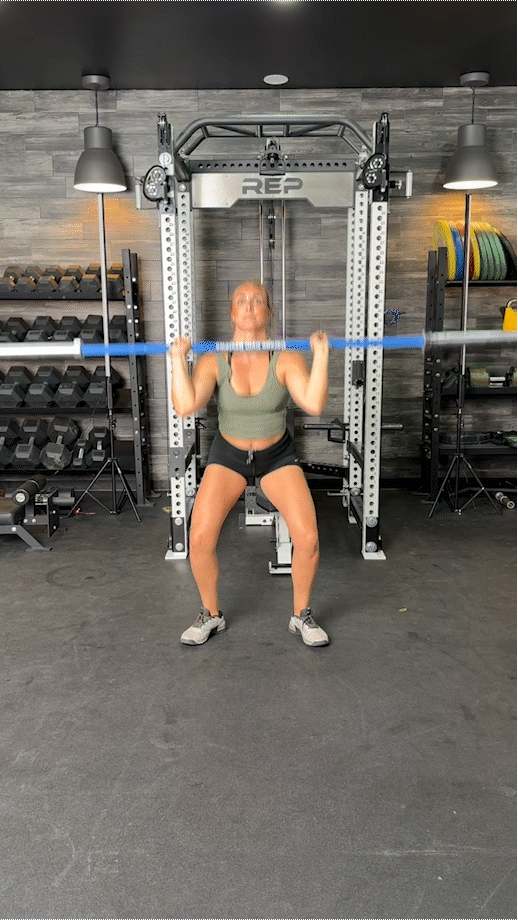
Modifications
- Dial it back: Perform a half squat rather than a full-depth one to lessen the load on your lower body.
- Make it harder: Perform two presses per rep to test your upper-body strength and endurance.
RELATED: Kettlebell Thruster
Bridge Pullover
Muscles worked: Glutes, hamstrings, erector spinae, latissimus dorsi, triceps, core
Benefits: Building a strong posterior chain can help keep lower back issues at bay and allow you to perform better on key lifts like the deadlift and barbell bent-over row. The bridge pullover effectively targets your glutes, hamstrings, and core muscles while also engaging your deltoids and lats. Look at it as a full-body exercise that gives you incredible bang for your buck—especially if you focus on a slow, controlled tempo to increase time under tension.
How to do it:
- Lie on your back with your feet hip-width apart, knees bent, and feet planted on the floor.
- Hold a weight plate with both hands, keeping your arms extended toward the ceiling.
- Lift your hips off the ground to form a bridge.
- Slowly lower the weight plate behind your head while maintaining a bridge position.
- Lower the weight until you feel a stretch in your chest and shoulders, then pull the plate back to the starting position.
- Repeat for the desired number of reps.
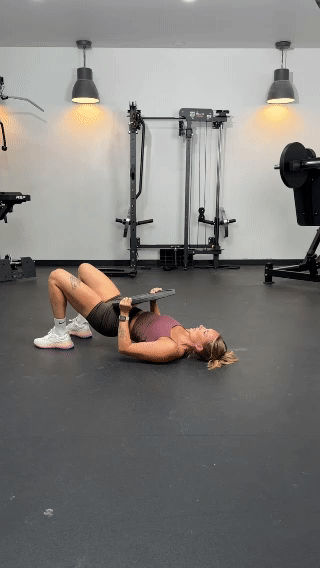
Modifications
- Dial it back: Lower your hips to the floor after each rep to give your glutes, hamstrings, and core a brief rest.
- Make it harder: Perform single-leg bridge pullovers to work on any imbalances or weaknesses.
RELATED: Best Hamstring Exercises
Standing Chest Squeeze Press
Muscles worked: Pectorals, deltoids, triceps, biceps, rhomboids, core
Benefits: The standing version of the chest squeeze press involves your core and shoulders more than the supine version. This exercise is great for developing your pecs, triceps, and anterior delts, as you must squeeze the plate(s) together from start to finish.
How to do it:
- Stand with your feet shoulder-width apart.
- Hold a weight plate with both hands at chest level so your elbows are bent and close to your sides.
- Squeeze the weight plate between your hands to engage your pecs.
- Engage your core, then press the plate straight out in front of you until your arms are fully extended.
- Hold the contraction for one second, then slowly bend your elbows to bring the plate back to the starting position.
- Repeat for the desired number of reps.
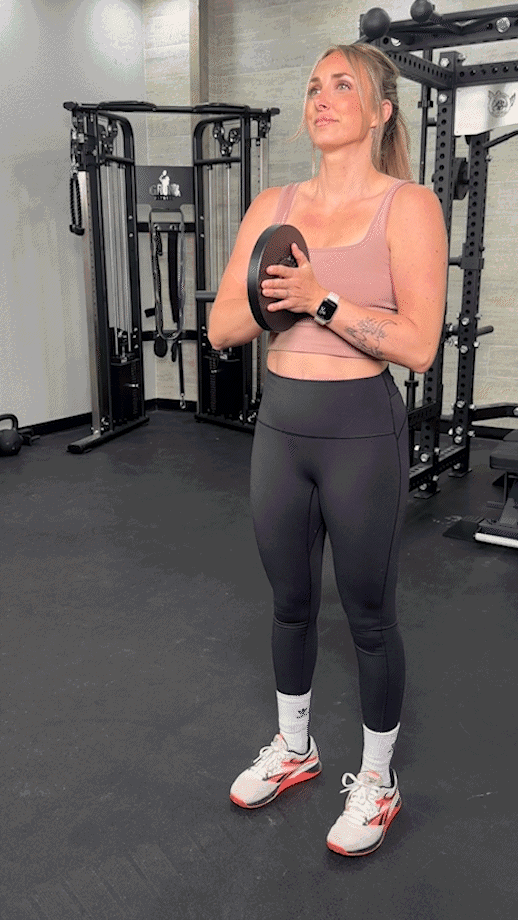
Modifications
- Dial it back: Perform the chest squeeze press while lying on a weight bench for added support.
- Make it harder: Change the tempo by accentuating the eccentric phase, which will put more tension on your chest, biceps, triceps, and shoulders.
RELATED: Inner Chest Workout
Shoulder Press
Muscles worked: Deltoids, triceps, pectoralis major, core
Benefits: The overhead press remains one of the best shoulder exercises because it activates not only your delts but also your traps and triceps. While you can perform this movement with a barbell, dumbbells, kettlebells, or a resistance band, you can still get a great muscle-building stimulus using only weight plates.
How to do it:
- Stand with your feet shoulder-width apart, holding a weight plate at chest level.
- Engage your core, then press the plate overhead until your arms are fully extended.
- Lower the plate back to chest level under control.
- Repeat for the desired number of reps.
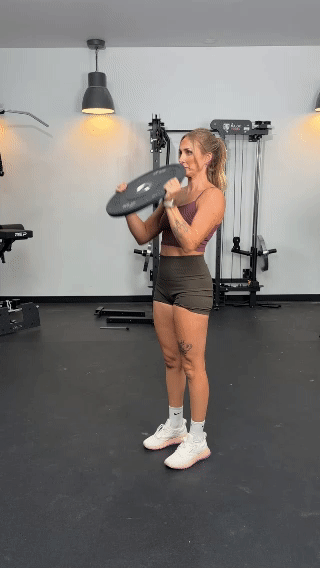
Modifications
- Dial it back: Perform a seated shoulder press to reduce the demand on your core and stabilizing muscles.
- Make it harder: Add an isometric hold at the top of the movement by holding the weight plate overhead for two to three seconds.
RELATED: Viking Press
Bent-Over Row
Muscles worked: Latissmus dorsi, rhomboids, rear deltoids, biceps, erector spinae, core
Benefits: Build a strong, thick back and a stable core with this variation of the barbell row. The plate row will allow you to work on your hip hinge mechanics while engaging your lats, rhomboids, and rear delts.
How to do it:
- Stand with your feet hip-width apart, holding a weight plate with both hands.
- Bend your knees slightly and hinge at the hips.
- Keep your back straight, engage your core, and pull the plate toward your chest.
- Squeeze your shoulder blades together, then lower the plate back to the starting position.
- Repeat for the desired number of reps.
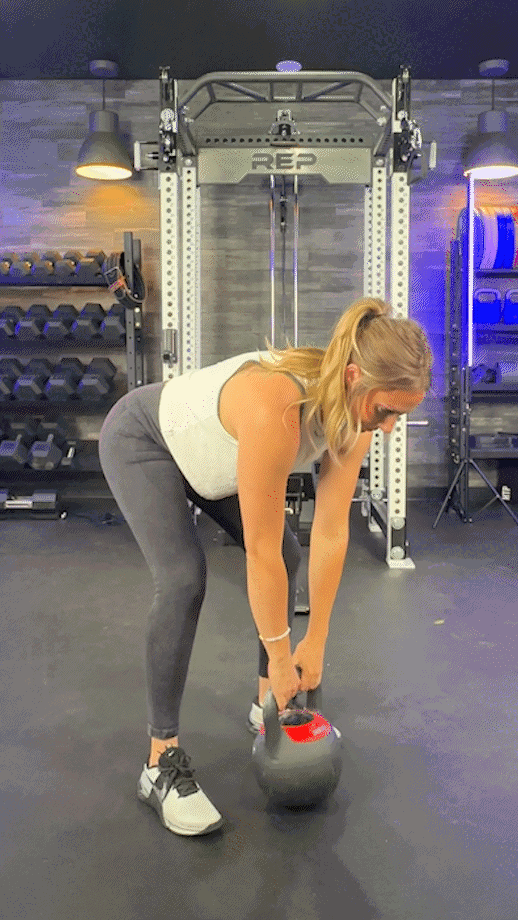
Modifications
- Dial it back: Use a weight bench for a chest-supported row if you have any back issues or struggle with the hip hinge.
- Make it harder: Superset the bent-over row with Romanian deadlifts for the ultimate posterior chain builder.
RELATED: 10 Best Bent-Over Row Variations
Front Shoulder Raise
Muscles worked: Deltoids, pectorals, latissimus dorsi, core
Benefits: Want to look intimidating in a tank top? Pencil the plate front shoulder raise into your upper-body routine. This timeless exercise will allow you to mold massive front delts, giving you that rounded aesthetic that’ll turn heads.
How to do it:
- Stand with your feet shoulder-width apart, holding a weight plate with both hands in front of your thighs.
- Keep your arms completely straight and lift the plate till your arms are parallel to the floor.
- Lower the plate back to the starting position under control.
- Repeat for the desired number of reps.
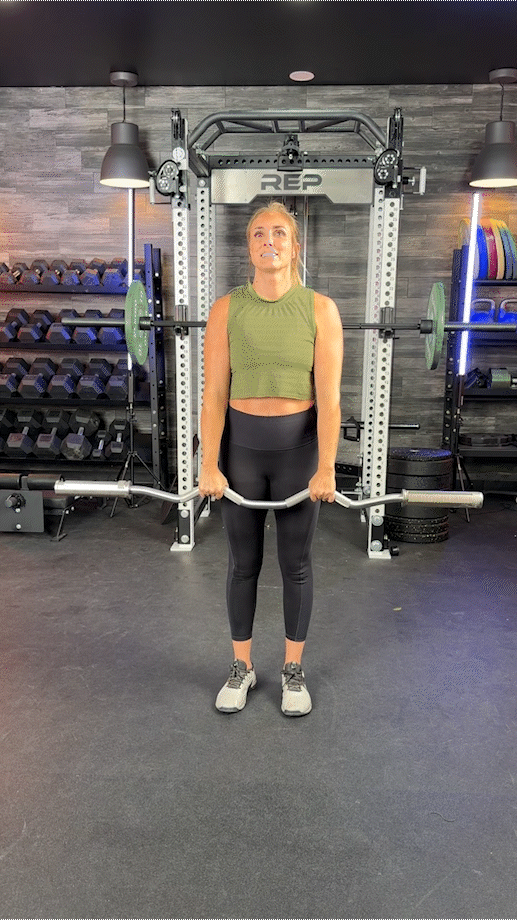
Modifications
- Dial it back: Perform the exercise from a seated position to reduce the load on your core and legs.
- Make it harder: Hold a weight plate in each hand with both arms fully extended in front of you. Alternate between front raises so one arm remains extended at all times.
RELATED: Best Shoulder Exercises
Plate Push-Up
Muscles worked: Pectorals, deltoids, triceps, rhomboids, core
Benefits: While there’s nothing wrong with standard push-ups, this variation increases the range of motion by elevating you off the ground. Every part of your upper body will be put to the test, primarily your triceps and chest.
How to do it:
- Set up a pair of weight plates on the floor so they’re at least shoulder-width apart.
- Place a hand on each plate and extend your arms to get into a push-up position.
- Lower yourself toward the floor until you feel a deep stretch in your pecs.
- Pause for one second at the bottom, then extend your arms to return to the starting position.
- Repeat for the desired number of reps.

Modifications
- Dial it back: Use a thinner plate to reduce the range of motion.
- Make it harder: Add a plyometric element such as clapping between reps.
RELATED: 17 Push-Up Variations
Overhead Triceps Extension
Muscles worked: Triceps, latissimus dorsi, core
Benefits: Create that signature horseshoe shape with one of the most popular triceps exercises. The plate overhead triceps extension puts a massive stretch on this three-headed muscle while also forcing you to maintain a stable core.
How to do it:
- Stand with your feet shoulder-width apart, holding a weight plate overhead with both hands.
- Keep your elbows tucked and close to your head.
- Lower the plate behind your head until you feel a deep stretch in your triceps.
- Extend your arms to lift the plate overhead.
- Lower the plate under control and repeat for the desired number of reps.
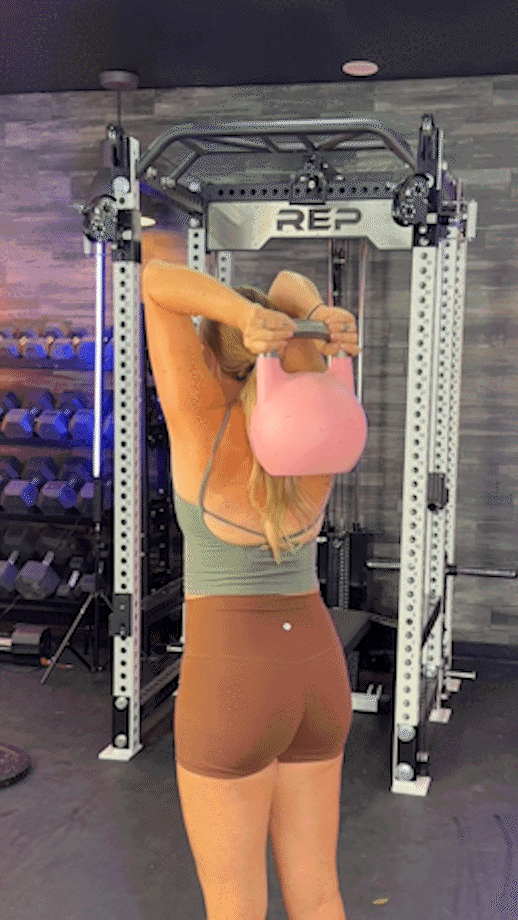
Modifications
- Dial it back: Perform the overhead triceps extension with a light resistance band if you aren’t ready to use a weight plate just yet.
- Make it harder: Perform the exercise while kneeling on a yoga mat (or the floor) to avoid generating any momentum from your lower body.
RELATED: 11 Triceps Extension Variations
Farmer’s Walk
Muscles worked: Trapezius, latissimus dorsi, rhomboids, quadriceps, glutes, hamstrings, forearms, core
Benefits: A conditioning exercise that has a direct carryover to everyday life, the farmer’s walk will test your grip strength, shoulder stability, and cardio capacity. It may sound and look simple, but don’t be shocked if you struggle to hold on to the weight plates as you cross the finish line.
How to do it:
- Stand with your feet shoulder-width apart, holding a weight plate in each hand.
- Keep your back straight and shoulders and core engaged.
- Walk forward for a set amount of time or distance.
- Turn around and walk back to the starting point, carefully lowering the weights to the floor when finished.
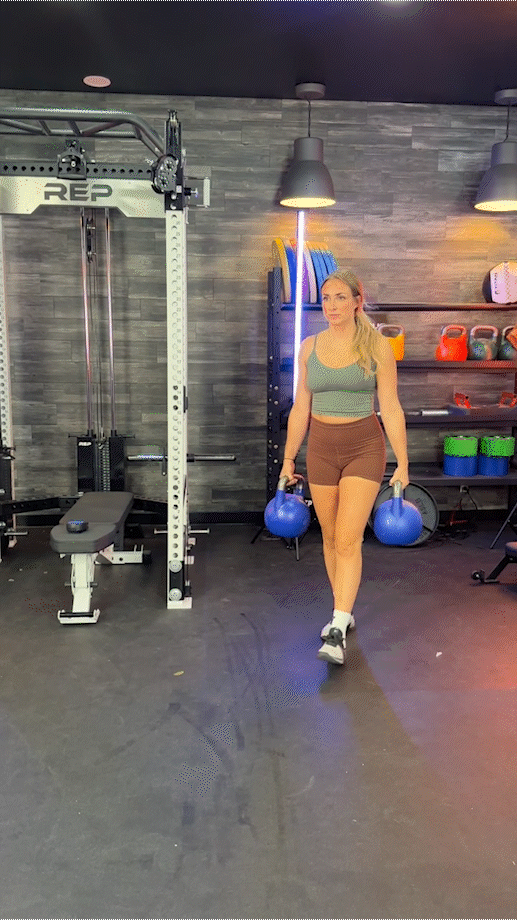
Modifications
- Dial it back: Reduce the distance or time interval to allow for adequate recovery between sets.
- Make it harder: Turn the farmer’s walk into walking lunges for a conditioning exercise that also brings strength- and muscle-building benefits.
RELATED: Farmer’s Walk Benefits
Halo
Muscles worked: Deltoids, trapezius, triceps, latissimus dorsi, obliques, rectus abdominis
Benefits: The halo exercise can help improve your shoulder mobility and stability while simultaneously engaging your abdominal and upper-back muscles. I recommend starting with a light weight so you get used to the motion before going heavier.
How to do it:
- Stand with your feet shoulder-width apart, holding a weight plate in front of your chest with both hands.
- Keep your core engaged and circle the plate around your head in a clockwise motion.
- Perform the desired number of reps, then reverse direction and repeat the process.

Modifications
- Dial it back: Perform halos from a seated position to take some of the demand off your core and lower body.
- Make it harder: Rotate the weight plate around your head in different angles and directions to challenge your coordination and mobility.
RELATED: Kettlebell Around the World
Russian Twist
Muscles worked: Obliques, rectus abdominis, erector spinae, hip flexors
Benefits: Russian twists target your obliques and core by testing your rotational strength. You can use just about any type of weight to perform this exercise. Make sure to engage your abs rather than relying on your hip flexors to keep your legs elevated.
How to do it:
- Sit on the floor with your knees bent and feet planted.
- Hold a weight plate with both hands at chest level.
- Lean back slightly and lift your feet off the ground.
- Rotate your torso to the right, touching the plate to the side of your hip.
- Rotate to the left, touching the plate to your other hip.
- Repeat for the desired number of reps.
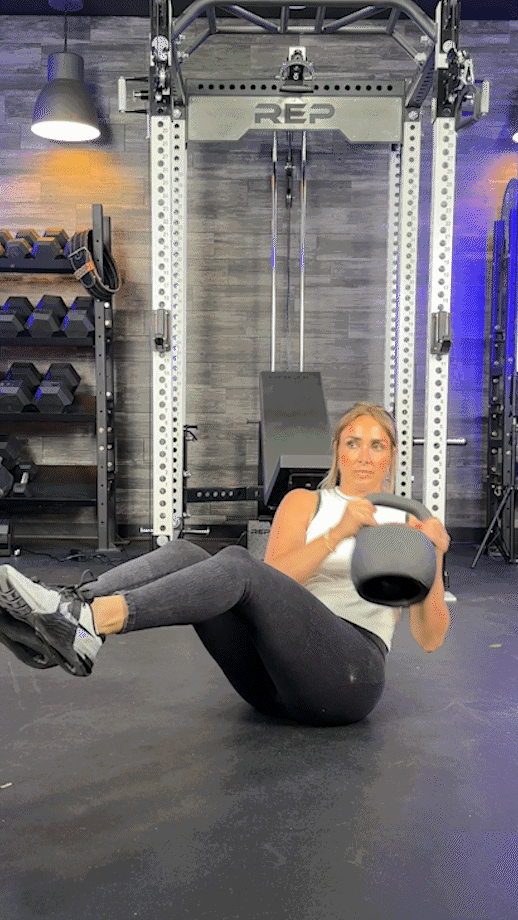
Modifications
- Dial it back: Keep your feet on the ground to take some tension off your core and hip flexors.
- Make it harder: Slow down the pace so you don’t use momentum to swing back and forth.
RELATED: Best Ab Exercises
V-Up
Muscles worked: Latissimus dorsi, deltoids, core, hip flexors
Benefits: This ab exercise is really more of a full-body movement, as you must control the weight plate with your upper body, raise your legs, and engage your abs. The V-up is one of my personal favorites for building a rock-solid core, especially if you go at a slow, deliberate pace to increase time under tension.
How to do it:
- Lie flat on your back with your legs fully extended.
- Hold a weight plate behind you with your arms fully extended.
- Lift your legs and arms simultaneously so they come together to form a “V” shape.
- Squeeze your abs, then slowly lower your arms and legs to the floor to return to the starting position.
- Repeat for the desired number of reps.
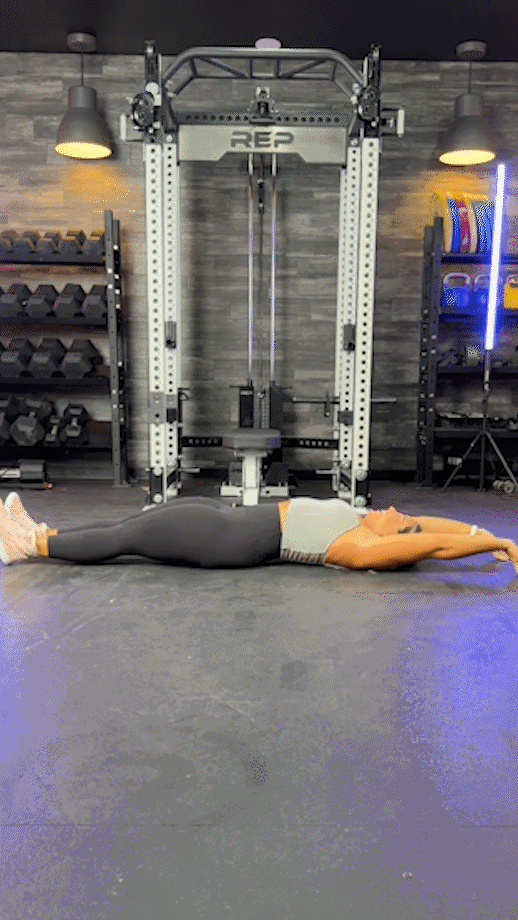
Modifications
- Dial it back: Hold the weight directly above your head and perform leg raises, gradually bringing it further behind you to provide a stretch on your abs.
- Make it harder: Hold a weight plate in each hand and perform single-leg V-ups for a unique unilateral challenge.
RELATED: 14 Functional Core Exercises
Side Bend
Muscles worked: Obliques, rectus abdominis, latissimus dorsi, trapezius, forearms
Benefits: The side bend effectively targets your obliques—a set of two broad abdominal muscles that assist in bending, rotating, and flexing your trunk forward. Although this exercise doesn’t require much technical prowess, it won’t take long before you feel a burn in the sides of your abs—if you choose a heavy enough weight plate.
How to do it:
- Stand with your feet about hip-width apart.
- Hold a weight plate in your right hand, keeping your arm close to your side.
- Bend to the side, slowly lowering the weight plate toward your knee while keeping your legs straight.
- Contract your obliques, raising your upper body back to the starting position.
- Repeat for the desired number of reps, then switch sides.
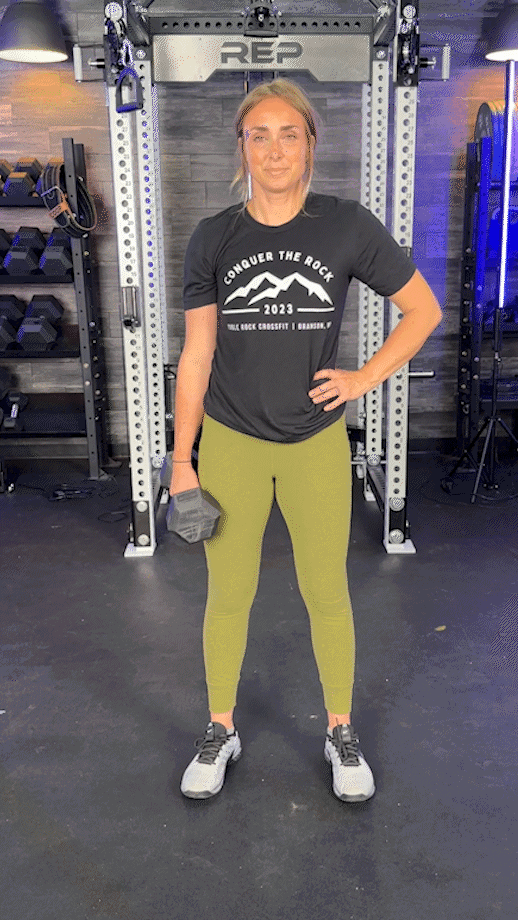
Modifications
- Dial it back: Perform side bends while seated on a weight bench to reduce the demand on your lower body.
- Make it harder: Pause at the bottom of the side bend and hold for a few seconds to increase time under tension on your obliques and core.
RELATED: How To Do the Side Plank
Woodchopper
Muscles worked: Deltoids, latissimus dorsi, pectorals, obliques, rectus abdominis
Benefits: Plate woodchoppers also help develop rotational strength and core stability. This dynamic exercise effectively targets your shoulders, obliques, and other abdominal muscles.
How to do it:
- Stand with your feet shoulder-width apart, holding a weight plate with both hands at waist level.
- Lift the plate diagonally across your body from your left hip to your right shoulder.
- Return to the starting position and repeat for the desired number of reps.
- Switch sides and repeat the process.
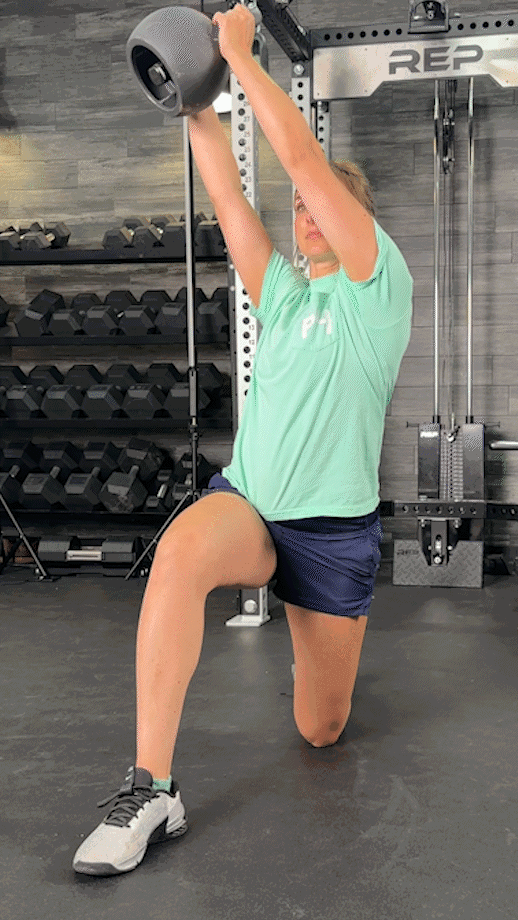
Modifications
- Dial it back: Use a light resistance band to allow for a more controlled range of motion.
- Make it harder: Combine the woodchopper with a lunge for a killer quad-and-core-building combo.
RELATED: Oblique Workouts
Weighted Plank
Muscles worked: Deltoids, rhomboids, latissimus dorsi, pectorals, quadriceps, hamstrings, glutes, core
Benefits: Planks are one of my favorite core exercises because they’re simple and highly adaptable. Adding a plate on your back makes this bodyweight exercise even more difficult, as you must engage your abdominal and lower-back muscles to maintain a neutral spine.
How to do it:
- Get in a plank position by anchoring your forearms and toes to the ground, keeping your back flat and head in a neutral position.
- Have a partner carefully place a weight plate on your back.
- Hold the position for the desired amount of time.
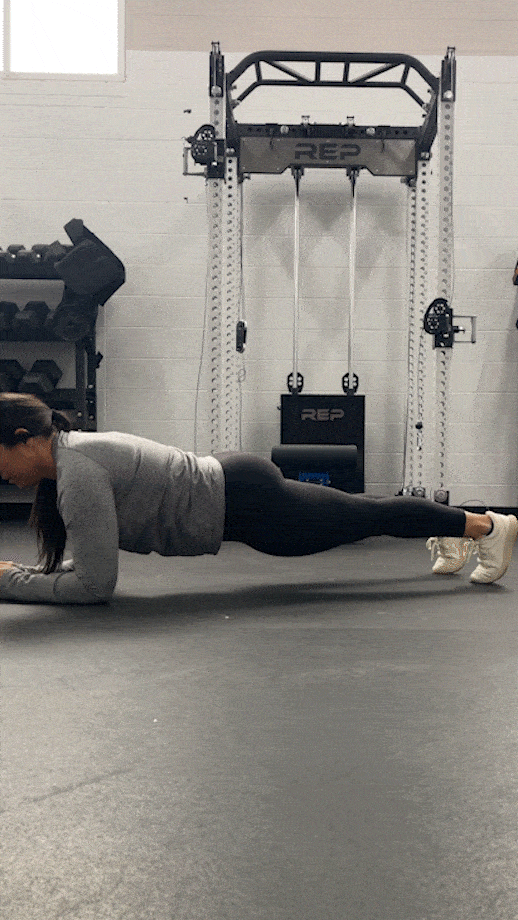
Modifications
- Dial it back: Alternate between weighted and non-weighted planks until you build sufficient strength and stamina.
- Make it harder: Increase the duration or simply stack on more plates to ramp up the difficulty. You can also try single-leg planks or other dynamic variations.
RELATED: 13 Plank Exercises
Sample Weight Plate Workouts
Ready to put those weight plates to work? I put together four highly focused training plans that’ll get all your muscle groups firing. With separate workouts for upper body, lower body, full body, and core, you have plenty of variety to keep things fresh and interesting.
Upper-Body Weight Plate Workout
Unlock upper-body #gains with this six-exercise weight plate workout. This session takes a balanced approach by targeting your chest, back, shoulders, and triceps with different set and rep schemes. After you make it through the first five exercises, wrap up with four rounds of plate push-ups, culminating in a burnout set till failure.
| Exercise | Sets | Reps |
| Chest Squeeze Press | 4 | 8 |
| Row | 4 | 8 |
| Overhead Press | 4 | 8 |
| Overhead Triceps Extension | 3 | 12-15 |
| Front Raise | 3 | 12-15 |
| Plate Push-Up | 4 | 10-12 (AMRAP on final set) |
RELATED: Upper-Body Workout at Home
Lower-Body Weight Plate Workout
While I wouldn’t abandon classic leg exercises like the leg press, hack squat, and leg extensions, you can still construct a rock-solid lower half using weight plates. This training session includes two lunge variations, as well as a squat variation that gets your upper body involved, too. If you want to take this lower-body weight plate workout to the next level, try performing it as a circuit, taking a two- or three-minute rest break between rounds.
| Exercise | Sets | Reps |
| Squat Reach | 4 | 8-10 |
| Overhead Lunge | 4 | 8-10 (per leg) |
| Bridge Pullover | 4 | 10-12 |
| Reverse Lunge and Twist | 4 | 8-10 (per leg) |
| Thruster | 4 | 8-10 |
| Weighted Plank | 4 | 30-45 sec. |
RELATED: Bodyweight Leg Workout
Full-Body HIIT Weight Plate Workout
Want to get stronger and fitter without having to count reps? This full-body high-intensity interval training (HIIT) workout challenges you to complete four rounds of an exercise before moving on to the next one. I included a mix of upper, lower, and core movements so you can feel accomplished from head to toe by the time you’ve emptied your tank.

| Exercise | Sets | Work Interval | Rest Interval |
| Thruster | 4 | 30 sec. | 30 sec. |
| Row | 4 | 30 sec. | 30 sec. |
| Plate Push-Up | 4 | 30 sec. | 30 sec. |
| Russian Twist | 4 | 30 sec. | 30 sec. |
| Farmer’s Walk | 4 | 30 sec. | 30 sec. |
| Woodchopper | 4 | 30 sec. | 30 sec. |
RELATED: HIIT Workouts for Men
Core Weight Plate Workout
Torch your core with this straightforward (but highly challenging) weight plate ab workout. This intense training session will challenge both your strength and endurance, as you’ll perform seven exercises and well over 200 reps. Remember to implement progressive overload by ramping up the number of reps/sets or using heavier weight plates as you get stronger and fitter.
| Exercise | Sets | Reps |
| Halo | 3 | 15 |
| Russian Twist | 3 | 15 (per side) |
| V-Up | 3 | 15 |
| Side Bend | 3 | 15-20 (per side) |
| Woodchopper | 3 | 10-15 (per side) |
| Bridge Pullover | 3 | 15-20 |
| Weighted Plank | 3 | 30-45 sec. |
RELATED: Beginner Core Workout
Weight Plate Exercises: Final Thoughts
Make no mistake about it: Weight plates belong on a barbell. But if you don’t have access to one, or you simply want to switch up your strength training routine, you can still accomplish your fitness goals with a circular piece of rubber or iron.
Don’t be surprised if the weight plate exercises I selected challenge you more than some of your go-to barbell and dumbbell movements. In fact, you may end up adding these home workouts to your plate more often than you’d expect to give your mind and body something new to chew on.
Weight Plate Exercises: FAQs
Are weight plate workouts effective?
Weight plate workouts can be effective for building strength and muscle and improving your overall fitness—especially if you focus on compound movements and train at an appropriate intensity level.
What are weight plate halos good for?
Weight plate halos can help improve your shoulder strength, mobility, and stability. They also effectively engage your core and upper-back muscles.
How often should I incorporate weight plate exercises into my workout routine?
As a certified personal trainer, I recommend including weight plate exercises in at least two or three workouts per week. They can be a great way to balance training with heavier loads with dumbbells, kettlebells, or barbell-based exercises.
Can weight plate exercises replace traditional dumbbell or barbell workouts?
Although weight plate exercises can be effective for building strength and muscle, you should use them as a complementary part of your dumbbell or barbell workouts. Range of motion limitations and grip strength issues can make it challenging to rely solely on weight plate exercises.
Can you get a full-body workout using only weight plates?
Yes, you can easily put together an effective full-body weight plate workout by incorporating a mix of exercises like the squat reach, thrusters, weighted pull-ups, and push-ups and core moves like V-ups, halos, and weighted planks.

